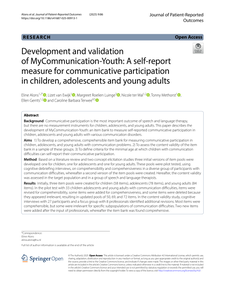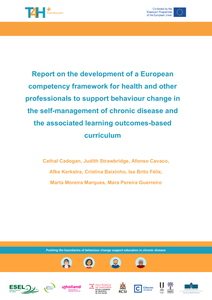We designed and held a romantic speed-dating experience at three locations, one in the Netherlands, one in the US, and one in China. We manipulated self-disclosure and tried to predict matches from participants' physiological body reactions.
DOCUMENT
If brief and easy to use self report screening tools are available to identify frail elderly, this may avoid costs and unnecessary assessment of healthy people. This study investigates the predictive validity of three self-report instruments for identifying community-dwelling frail elderly.
DOCUMENT

Abstract Objective: To determine the associations between four validated multidimensional self-report frailty scales and nine indices of oral health in communitydwelling older persons. Materials and Methods: This pilot study was conducted in a sample of 208 older persons aged 70 years and older who visited two dental practices in the Netherlands. Frailty status was measured by four different self-report frailty questionnaires: Tilburg Frailty Indicator (TFI), Groningen Frailty Indicator (GFI), Sunfrail Checklist (SC), and the Sherbrooke Postal Questionnaire (SPQ). Oral health was assessed by two calibrated examiners. Results: The prevalence of frailty according to the four frailty measures TFI, GFI, SC, and SPQ was 32.8%, 31.5%, 24.5%, and 49.7%, respectively. The SC correlated with four oral health variables (DMFT, number of teeth, percentage of occlusal contacts, Plaque Index), the TFI with three (number of teeth, percentage of occlusal contacts, Plaque Index), the GFI only with DPSI, and the SPQ with the number of teeth and the number of occlusal contacts. Conclusion: Of the studiedmultidimensional frailty scales, the SC and TFIwere correlated with most oral health variables (four and three, respectively). However, it should be noticed that these correlations were small. Clinical relevance: The SCand TFImight help to identify older people with risk of poor oral health so that preventive care can be used to ensure deterioration of oral health and maintenance of quality of life. Vice versa early detection of frailty by oral care professionals could contribute to interprofessional management of frailty.
DOCUMENT

This study was conducted in accordance with the Declaration of Helsinki, and the protocol was approved by the institutional medical ethic committee (number CWO -1911) and funded by Altrecht Mental Health Care. All participants of this study signed informed consent. The participants of this study did not give written consent for their data to be shared publicly outside of the Mental Health Institute were the data were generated. Derived data will be available conform APA policy to other researchers upon request. All authors had full access to the data in the study and take responsibility for the integrity of the data and the accuracy of the data analysis. The authors have no conflicts of interest to report. Abstract Epistemic trust (ET) refers to the predisposition to trust information as authentic, trustworthy and relevant to the self. Epistemic distrust – resulting from early adversity – may interfere with openness to social learning within the therapeutic encounter, reducing the ability to benefit from treatment. The self-report Questionnaire Epistemic Trust (QET) is a newly developed instrument that aims to assess ET. This study presents the first results on the psychometric properties of the QET in both a community and a clinical sample. Our findings indicate that the QET is composed of four meaningful subscales with good to excellent internal consistency. The QET shows relevant associations with related constructs like personality functioning, symptom distress and quality of life. QET scores clearly distinguish between a clinical and community sample and are associated with the quality of the therapeutic alliance. The QET provides a promising, brief and user-friendly instrument that could be used for a range of clinical and research purposes. Future studies with larger samples are needed to strengthen construct validity and to investigate the value of the QET to predict differential treatment responses or to study mechanisms of change.
LINK
BACKGROUND: Communicative participation is the most important outcome of speech and language therapy, but there are no measurement instruments for children, adolescents, and young adults. This paper describes the development of MyCommunication-Youth: an item bank to measure self-reported communicative participation in children, adolescents and young adults with various communication disorders.AIMS: 1) To develop a comprehensive, comprehensible item bank for measuring communicative participation in children, adolescents, and young adults with communication problems. 2) To assess the content validity of the item bank in a sample of these groups. 3) To define criteria for the minimal age at which children with communication difficulties can self-report their communicative participation.METHOD: Based on a literature review and two concept elicitation studies three initial versions of item pools were developed: one for children, one for adolescents and one for young adults. These pools were pilot tested, using cognitive debriefing interviews, on comprehensibility and comprehensiveness in a diverse group of participants with communication difficulties, whereafter a second version of the item pools were created. Hereafter, the content validity was assessed in the target population and in a group of speech and language therapists.RESULTS: Initially, three item pools were created for children (58 items), adolescents (78 items), and young adults (84 items). In the pilot test with 33 children adolescents and young adults with communication difficulties, items were revised for comprehensibility, some items were added for comprehensiveness, and some items were deleted because they appeared irrelevant, resulting in updated pools of 50, 69, and 72 items. In the content validity study, cognitive interviews with 27 participants and a focus group with 8 professionals identified additional revisions. Most items were comprehensible, but some were irrelevant for specific subpopulations of communication difficulties. Two new items were added after the input of professionals, whereafter the item bank was found comprehensive.CONCLUSIONS: MyCommunication-Youth is an item bank for measuring communicative participation in children, adolescents and young adults with various communication difficulties. Three versions of the instrument were created: MyCommunication-Children of 49 items, MyCommunication-Adolescents of 70 items and MyCommunication-YoungAdults of 73 items. The item bank is comprehensible, relevant and comprehensive according to the target population and target professionals.
DOCUMENT

This study was motivated by a desire to help working-age individuals gain a better understanding of their daily nutritional intakes with a new self-reported dietary assessment method because an unhealthy eating behavior increases the risks of developing chronic diseases. In this study, we present the design and evaluation of NutriColoring, a food diary that leverages doodling on sketches to report and reflect on everyday diet in the working context. Through a 2-week field study involving 18 participants, the usefulness of NutriColoring in facilitating dietary assessment was tested by making comparisons with the typical bullet diary method. Our quantitative results showed that NutriColoring provided users with improved dietary assessment experience and intrinsic motivations, with significantly low task frustration and high enjoyment. Because of the freedom and playfulness in reporting intakes at work, the interview findings showed a high acceptance of employing NutriColoring at work. This article is concluded with a set of implications for the design and development of a Doodling toolkit to support healthy eating behaviors among office workers.
DOCUMENT

It is commonly assumed that TV commercials successfully influence affective tourism destination image by coupling positive emotions to a destination. In this study we record emotional responses to destination pictures before and after viewing a destination TV commercial from participants’ brains using electroencephalography (EEG). A control group of participants watched the same destination pictures, and an unrelated TV commercial. Emotion-related event-related potential (ERP) components, the P2 and LPP, were derived from the EEG. For the participants that watched the destination TV commercial, the P2 and the LPP were larger in response to destination pictures after compared to before having watched the TV commercial. This effect was not observed in the control group. In a behavioral version of the same experiment, we did not observe any effects in the self-report data. It is concluded that ERP methodology is a useful tool to complement the toolbox of tourism marketing researchers
LINK
Interviews with students, lecturers, researchers, management and professional field.
DOCUMENT
Chronic diseases represent a significant burden for the society and health systems; addressing this burden is a key goal of the European Union policy. Health and other professionals are expected to deliver behaviour change support to persons with chronic disease. A skill gap in behaviour change support has been identified, and there is room for improvement. Train4Health is a strategic partnership involving seven European Institutions in five countries, which seeks to improve behaviour change support competencies for the self-management of chronic disease. The project envisages a continuum in behaviour change support education, in which an interprofessional competency framework, relevant for those currently practising, guides the development of a learning outcomes-based curriculum and an educational package for future professionals (today’s undergraduate students).
DOCUMENT
